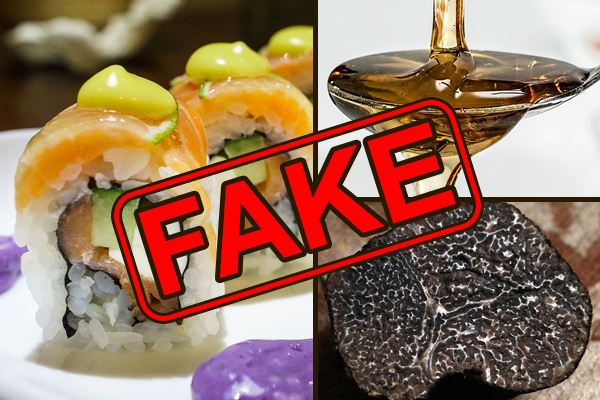One of the privileges of living in the 21st century is the ability to find quality food items and even import foreign food that would otherwise be inaccessible. Unfortunately, there is a price to pay with this system as many take advantage of the customers’ growing demands.
Food fraud is a $50 billion annual industry, which continues to grow each year and affects many consumers. Whether you are a health enthusiast that is being tricked into buying fake honey or olive oil, or a foodie paying top dollar for imitation lobster or truffle oil, food fraud affects most of us at some point.
From grocery stores and market to restaurant and coffee shops, here is the list of top twelve foods that are most commonly found to be fake.
Olive Oil
Olive oil has many health benefits; it is anti-inflammatory, and helps prevents strokes and heart disease. It is wonderful oil to use…if you find a real one. As Olmsted found out, olive oil is one of the most common fake foods in the U.S – 80-85% of it is fake.
“This is one of the most pervasive Fake Foods in America, reaching deep into home kitchens, restaurants, and supermarkets, and not unfamiliar to the government agencies supposedly watching over our food supply,” Olmsted writes.
Instead of pure olive oil, what you are commonly buying is peanut oil and even soybean oil – a likely GMO food.
To find real olive oil, look for seals from quality assurance organizations, or better yet “know your farmer.”
Honey
What many people do not realize is that there no real standards to what can be called “honey” when sold in little glass jars. As a result, many places sell honey diluted with sugar, sweeteners, high-fructose corn syrup, or even illegal antibiotics.
Thankfully most farmer’s markets include products from local beekeepers that are generally authentic. Do your best to know your source before buying, and ask plenty of questions if you’re skeptical.
Fish
There are many fish species in the world. And those who love fish know that many taste very different from one another. In restaurants however, you never know if you are going to get what you ordered. Fish served there and fish sold in stores is often mislabeled.
Red snapper, for example, is fake 94% of the time, as a DNA testing study showed. Sold as a red snapper is a much cheaper fish filet made of various other species. The same is true for many other types of fish. Tuna is also fake an estimated 94% of the time, especially when it is served at sushi restaurants. Instead of tuna, sushi bars often use escolar, a type of fish that often is responsible for giving people diarrhea.
Experts say that if you are buying or ordering an expensive fish, and it is never shown to you whole, you are very likely to be scammed.

Fruit Juice
When buying fruit juice – no matter what kind – you might end up drinking a lot of apple juice. Many companies add apple juice to cut any other fruit juices, because apples are cheaper.
But this scam does not stop there. Even though apples are inexpensive, Chinese-made apple concentrate is even cheaper, and that is what you are likely to be drinking.
Check your ingredients lists and buy from trusted companies, or make your own to avoid these scams.
Coffee
As common as coffee is, it is also often cut with cheaper materials in order for the seller to make more money on it. The hidden ingredients in it can be: twigs, corn, barley, and parchment. It gets worse when it comes to instant coffee. It can be mixed with chicory, cereals, caramel, parchment, start, malt, and figs, according to Olmsted.
If you want a guarantee that your coffee is 100% pure, it is best to get the beans and grind it yourself.
Tea
Who does not like a cup of fresh brewed tea? Unfortunately, to keep teas smelling fresh longer, instead of disclosing its natural shelf life, some companies are adding sawdust to make teas last longer.
Buy from trustworthy organic and local producers to minimize this risk whenever possible.
Parmigiano-Reggiano Cheese
Real parmesan cheese is often named the King of Cheeses for its taste. But here in the U.S., you are likely to get stuck with many of its fake doubles. According to a 2016 FDA study, almost 100% of this cheese in the U.S. is mixed with cheaper cheese or even wood pulp to lower the costs.
If you want to find a real one, be sure to look for the rare “Made in Italy” stamp on it.
Japan’s Kobe Beef
Kobe beef is one of the most treasured meats in the meat industry. It has originated in Japan and receives an A5 grade for its taste, but now can be also raised in Australia or Japan. This meat is extremely expensive as it requires many steps to achieve its texture. The cows raised for Kobe beef are treated close to royalty…up until they are slaughtered. They are given beer. They receive daily massages. And they are even played classical music.
Spices
If you like to cook, you might have noticed that some cheap spices bought at supermarkets have no real smell or taste. Often, they smell like dried up weeds from outside. That is because they are often mixed with random ingredients. Turmeric is often mixed with corn; nutmeg – with pepper, and oregano with weeds.
Truffle Oil
Truffle oil is one of the recent food crazes, with restaurants serving French fries drizzled with “truffle oil,” and cafes are selling “truffle oil” popcorn. Sadly, none of the truffle oil dishes contain much if any truffle content. Truffles – real truffles – are extremely rare and expensive (real truffle oil can go for $90 per ounce).







